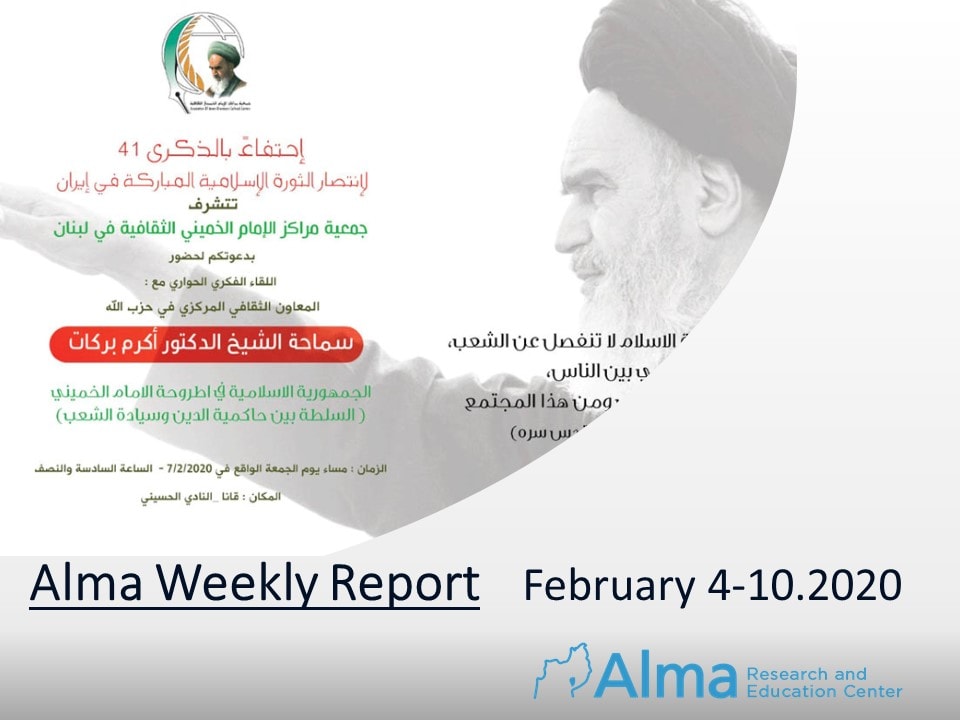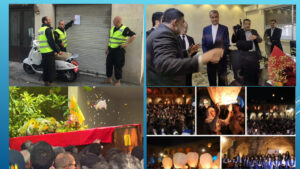The Trump administration’s “deal of the century”:
- In contrast to the first week following the publication of the Trump peace deal, this week the situation deteriorated into riots and civil disorder violations throughout Judea and Samaria, characterized by stone throwing, hurling of firebombs and accurate gunfire aimed at IDF forces. However, this is not to be considered a widespread uprising.
- Unfortunately, one of the perpetrators was a Christian Arab-Israeli citizen from Haifa, who recently converted to Islam.
- The Iranians, Hamas and the Palestinian Jihad are constantly trying to encourage the wave of violence in Judea and Samaria and are apparently supporting it.
The Lebanese arena
- Following are some of the Lebanese government basic new guidelines:
- The new guidelines will include an introduction that will support the popular protests that took place in Lebanon.
- The introduction content: “This government has arisen as a result of popular outrage throughout the homeland where the Lebanese have expressed their pain for their humiliating lives in a country that does not provide them with the minimum living needs”.
- Also, the new guidelines will include the following topics: ending the waste of money, strengthening the social security network, fighting corruption, introducing financial transparency, fighting poverty, introducing a new tax system and aiding private sector companies.
- Hezbollah is not mentioned in the new guidelines, it seems they were not included intentionally to elude the matter.
- The power of the new government to bring about real change and reform is highly questionable. This is not a government of technocrats as the protesters demanded; it is a political government belonging to the Hezbollah camp.
- Despite the protests, Hezbollah appears to be the main beneficiary of the situation in Lebanon.
- Fissures in Shiite unity as a result of popular protest? There are indications that the Amal movement is disappointed with Hezbollah’s conduct during the protests since Hezbollah places the blame on the Amal movement and its head (Nabia Bari, the parliament’s chairperson) as being responsible for the criticism directed at the Shi’ite community in addition to accusing them of corruption. In response, Nabia Berry demanded that Hezbollah stops the criticism otherwise, he will be forced to instruct his Amal activists to return to the streets to cause uncontrollable riots.
- Iranian Shi’ization and Influence – To mark the 41st anniversary of the Islamic Revolution in Iran, the Hamam Al-Khamenei Cultural Center in Lebanon issued an invitation inviting supporters to a rally together with Hezbollah’s Deputy Head of Cultural Unit Sheik Dr. Akram Barkat in the village of Kana in southern Lebanon on 2 February.

- Ali El Husseini
- Mohamad Ali El Husseini, the Shiite cleric, is seeking asylum in France due to death threats made against him and due to a prosecution awaiting him in Lebanon charging him with the collaboration with Israel, all because he joined the Muslim cleric’s delegation that visited Auschwitz two weeks ago (See weekly intelligence report 20 Jan. to 27Jan.2020).
- El Husseini is a Shiite cleric who has been in opposition to Hezbollah for many years.
- For many years, Hezbollah has contained el- Husseini’s activities in Lebanon and from time to time “reminded” him with short detentions and negative publicity threats not to overstep his boundaries.
- Hezbollah certainly took advantage of el- Husseini’s visit outside of Lebanon visiting Auschwitz to send him an unequivocal message that he has nothing to return to Lebanon for. Also, a lawsuit was filed against el- Husseini charging him of collaborating with Israel, thus blocking his return to Lebanon.
The Syrian arena
- Air raid attacks against targets in Syria (6 February):
- Airstrikes against military bases were carried out in the Damascus region (in the al Kiswah, al Mezzeh, Marj al-Sultan, and Jasser Baghdad [Baghdad Bridge] areas) in addition to strikes in the Daraa province in southern Syria (in the Azra region).
- Based on reports, 23 people were killed in the attacks: 15 of them Iranian militiamen, among them at least 3 Iranian citizens. Other reports state that among those killed was an officer in the Syrian army serving as the commander of the al Mezzeh military airport.
- According to the Russian Ministry of Defense, the attack endangered a civilian flight and that “the Israeli air force uses civilian aircraft as a defense against anti-aircraft systems, further stating that Israel does not care about civilians who may be hurt …”
- It is important to keep in mind that Russia throughout the entire Syrian civil war and even at present (in the Idlib and Aleppo provinces), assist the Syrian regime with indiscriminating Russian air force bombings. These bombings have hit, killed, and injured thousands of civilians and damaged countless infrastructures.
- We can make two assumptions about the Russian response: Firstly, the Russian army does not like the air operations targeting the Shiite axis in Syria, more so, when repeatedly they are forced to witness the failure of preventing the attacks with their air defense systems. Secondly, The Russian response is lip service only. Considering that these airstrikes are aimed at the Shi’ite axis supporting the Syrian regime and bearing in mind that the Syrian regime is a favorite of Russia, therefore the latter cannot help but respond as it has, at least outwardly. In practice, as long as the security coordination between Russia and Israel exists and as long as Russian soldiers are not affected directly by this activity, Israeli freedom of action will be maintained and the attacks will continue.
- The fighting in Idlib Province:
- Turkish President, Erdogan, on February 5th declared;” The Idlib understandings have collapsed and by the end of February the Syrian army must withdraw from all areas near the Turkish forces in Idlib … If the Syrian army does not withdraw, Turkey will force them to comply.
- Large Turkish reinforcement convoys containing hundreds of tanks, armored vehicles, and artillery and rocket launchers have reached the Idlib region intending to prevent the final collapse of the rebel organizations it supports.
- The rebels in the Idlib province (the rebel fighting force are essentially based on the ” Hay’ at Tahrir al-Sham organization – or by its old name Jabhat al-Nusra – most of which are affiliated with Al-Qaeda) are beginning to collapse. The inevitable occupation of the province by the Assad army and its supporters (Russian Air Force, Iranian militias and Hezbollah), is just a matter of time.
- Despite Erdogan’s declaration, the Assad army and its supporters surrounded the town of Saraqib (located 15 kilometers southeast of the city of Idlib city), conquered it and forcing the Turkish forces to withdraw to the northwest towards the city of Idlib.
- The Assad army and its supporters appear to be positioned in the strategic area of the M5 motorway linking Damascus with Aleppo.
- As of now, the Assad army forward forces and their supporters are about nine kilometers from the city of Idlib itself and it seems that the insurgent’s supply lines are cut off.
- It is important to note that the vast majority of the hundreds of thousands of displaced persons from the combat areas are advancing towards the Turkish border. The Turkish interest is to prevent those displaced persons from reaching the border; therefore, the Turkish interest is to prevent the continued progress of the Assad army and its supporters.
- Iran offered its services as a mediator between Turkey and the Syrian regime over the conflict in Idlib province.
- The battle of the Turkish forces and the rebels in the eastern part of Idlib has begun.
- The fighting in Aleppo Province:
- The Assad army and its supporters made great strides and managed to take control of 52 villages in the southern suburbs of Aleppo.
- In the below photo you can see an el-Nujaba militia combatant (Iraqi Shiite militia belonging to the Iranian-backed al-Ḥashd ash-Shaʿbī roof organization) hanging a picture of Qasem Soleimani and flying the militia flag on the Khalid bin el- Wallid mosque in the town of Elis in the southern Aleppo suburb after taking over the town.
- Evidently, in the fighting taking place in the Aleppo province a very large Shiite militia involvement is felt especially a militia of Hezbollah activists.

- During the battles in Idlib and Aleppo, we can witness many indications of the looting of civilian property and desecration of cemeteries performed by the Assad army and its supporters.
- On Facebook, under the heading “The Grave Shattering Community” (referring to the Allawi community), instead of the shattering of graves perpetrated by Assad’s military forces in areas occupied by them in the Idlib and Aleppo districts, we located a Facebook page of the Jabata al-Kashb, Uphania and Tenaranaja villages. (These are Sunni villages from southern Syria, which were focal points of major rebellions until their surrender in July 2018). The Facebook page displays a caption and caricature about the shattering and desecrating of the graves stating: “Despite the multitude of events and ugliness of some, history has not told us about the ugliness and impurity and filth of this faith, that at the center of this faith is the shattering of the graves of the dead. Assad, the criminal of Syria is from the descent of this faith“.

- In the caricature, you can see Syrian soldiers smashing Sunni graves and next to the Syrian President Bashar al-Assad, pointing to the grave of Eli Cohen (the Israeli spy in Syria, executed in the 1960’s, his place of burial unknown), with a David’s shield (Magen David) symbol on the headstone, telling the soldiers: “Keep this grave safe“…
- This Facebook post and caricature expresses the great hatred and animosity towards the Allawi regime and towards its supporters (the Shi’ite axis) in general and for President Assad in particular.
- The Shi’ization continues:
- In recent days, Iranian Shiite militias in Deir Ez-Zor in cooperation with the Syrian military forces have been conducting training courses for Syrian non-Shiite militiamen to familiarize them with Shi’ite principles and persuade them to undergo a Shi’ite conversion.
- These courses last 15 days.
- The centers in which these courses took place are in Deir Ez-Zor, el Mayadin, and el Bukamal.
- Commanders in charge of these centers and courses are Iranian and Iraqi citizens belonging to the Iranian Revolutionary Guards Unit.






